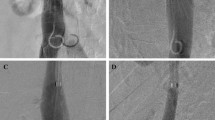Abstract
The objective of this study was to explore the role of three-dimensional (3-D) rotational angiography (RA) of the inferior vena cava (IVC; 3-D CV) before filter retrieval and its impact on treatment planning compared with standard anteroposterior cavography (sCV). Thirty patients underwent sCV and 3-D CV before IVC filter retrieval. Parameters assessed were: projection of filter arms or legs beyond the caval lumen, thrombus burden within the filter and IVC, and orientation of the filter within IVC. Skin and effective radiation doses were calculated. Statistical analysis was performed using paired Student t test and nonparametric McNemar’s test. Standard anteroposterior cavography detected 49 filter arms or legs projecting beyond the caval lumen in 25 patients. Three-dimensional CV demonstrated 89 filter arms or legs projecting beyond the caval lumen in 28 patients. Twenty-two patients had additional filter arms or legs projecting beyond the caval lumen detected on 3-D CV that were not detected on sCV (p < 0.001). Filter apex tilt detection differed significantly (p < 0.001) between sCV and 3-D CV, with 3-D CV being more accurate. The filter apex abutted the IVC wall in 10 patients (33%) on 3-D CV, but this was diagnosed in only 3 patients (10%) with sCV. Thrombus was detected in 8 patients (27%), 1 thrombus of which was seen only on 3-D CV, and treatment was changed in this patient because of thrombus size. Mean effective radiation doses for 3-D CV were approximately two times higher than for sCV (1.68 vs. 0.86 mSv), whereas skin doses were three times lower (12.87 vs. 35.86 mGy). Compared with sCV, performing 3-D CV before optional IVC filter retrieval has the potential to improve assessment of filter arms or legs projecting beyond the caval lumen, filter orientation, and thrombus burden.



Similar content being viewed by others
References
Quirke TE, Ritota PC, Swan KG (1997) Inferior vena caval filter use in U.S. trauma centers: a practitioner survey. J Trauma 43:333–337
Kaufman JA, Kinney TB, Streiff MB et al (2006) Guidelines for the use of retrievable and convertible vena cava filters: report from the Society of Interventional Radiology multidisciplinary consensus conference. J Vasc Interv Radiol 17:449–459
Abe T, Hirohata M, Tanaka N et al (2002) Clinical benefits of rotational 3D angiography in endovascular treatment of ruptured cerebral aneurysm. AJNR Am J Neuroradiol 23:686–688
Hirai T, Korogi Y, Suginohara K et al (2003) Clinical usefulness of unsubtracted 3D digital angiography compared with rotational digital angiography in the pretreatment evaluation of intracranial aneurysms. AJNR Am J Neuroradiol 24:1067–1074
Hochmuth A, Spetzger U, Schumacher M (2002) Comparison of three-dimensional rotational angiography with digital subtraction angiography in the assessment of ruptured cerebral aneurysms. AJNR Am J Neuroradiol 23:1199–1205
Anzalone N, Scomazzoni F, Castellano R et al (2005) Carotid artery stenosis: intraindividual correlations of 3D time-of-flight MR angiography, contrast-enhanced MR angiography, conventional DSA, and rotational angiography for detection and grading. Radiology 236:204–213
Ray CE Jr, Mitchell E, Zipser S et al (2006) Outcomes with retrievable inferior vena cava filters: a multicenter study. J Vasc Interv Radiol 17:1595–1604
Asch MR (2002) Initial experience in humans with a new retrievable inferior vena cava filter. Radiology 225:835–844
Servomaa A, Tapiovaara M (1998) Organ dose calculation in medical X-ray examinations by the program PCXMC. Radiat Prot Dosimetry 80:213–219
Gailloud P, Oishi S, Carpenter J et al (2004) Three-dimensional digital angiography: new tool for simultaneous three-dimensional rendering of vascular and osseous information during rotational angiography. AJNR Am J Neuroradiol 25:571–573
Hagen G (2004) Three-dimensional rotational angiography of transplanted renal arteries: a clinical and experimental study. Doctoral dissertation, Uppsala University, Uppsala, Sweden
Prestigiacomo CJ, Niimi Y, Setton A et al (2003) Three-dimensional rotational spinal angiography in the evaluation and treatment of vascular malformations. AJNR Am J Neuroradiol 24:1429–1435
Bucek RA, Reiter M, Dirisamer A et al (2004) Three-dimensional digital rotation angiography for embolization therapy of uterine leiomyomas: first results. Rofo 176:1001–1004
Unno N, Mitsuoka H, Takei Y et al (2002) Virtual angioscopy using 3-dimensional rotational digital subtraction angiography for endovascular assessment. J Endovasc Ther 9:529–534
Maddux JT, Wink O, Messenger JC et al (2004) Randomized study of the safety and clinical utility of rotational angiography versus standard angiography in the diagnosis of coronary artery disease. Catheter Cardiovasc Interv 62:167–174
Tanigawa N, Komemushi A, Kojima H et al (2004) Three-dimensional angiography using rotational digital subtraction angiography: usefulness in transarterial embolization of hepatic tumors. Acta Radiol 45:602–607
Bozlar U, Brayman KL, Hagspiel KD (2008) Pancreas allografts: comparison of three-dimensional rotational angiography with standard digital subtraction angiography. J Vasc Interv Radiol 19(2 Pt 1):239–244
Wicky S, Doenz F, Meuwly JY et al (2003) Clinical experience with retrievable Günther Tulip vena cava filters. J Endovasc Ther 10:994–1000
Author information
Authors and Affiliations
Corresponding author
Rights and permissions
About this article
Cite this article
Bozlar, U., Edmunds, J.S., Turba, U.C. et al. Three-Dimensional Rotational Angiography of the Inferior Vena Cava as an Adjunct to Inferior Vena Cava Filter Retrieval. Cardiovasc Intervent Radiol 32, 86–92 (2009). https://doi.org/10.1007/s00270-008-9405-6
Received:
Revised:
Accepted:
Published:
Issue Date:
DOI: https://doi.org/10.1007/s00270-008-9405-6




